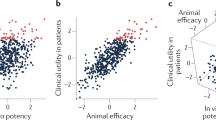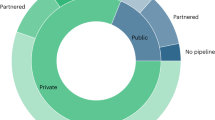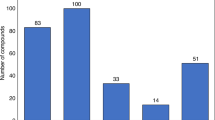Abstract
By combining innovative science with years of massive investment, drug makers seek to turn newly discovered chemicals into revolutionary blockbuster drugs that generate billions of dollars in revenue. So every year, they collectively spend tens of billions of dollars on the high-risk pursuit of the next Prozac or Viagra. But should they? This article analyses key themes around differentiation that we have found to be common among blockbusters, and examines the implications for creating future billion-dollar drugs.
This is a preview of subscription content, access via your institution
Access options
Subscribe to this journal
Receive 12 print issues and online access
$209.00 per year
only $17.42 per issue
Buy this article
- Purchase on Springer Link
- Instant access to full article PDF
Prices may be subject to local taxes which are calculated during checkout




Similar content being viewed by others
References
Fruits of Genomics (Lehman Brothers, New York, 2001).
Ma, P. & Zemmel, R. Value of novelty? Nature Rev. Drug Discov. 1, 571–572 (2002).
Landau, R. et al. Pharmaceutical innovation: Revolutionizing Human Health. Chemical Heritage Foundation (1999).
'The management of pharmacology' R&D Scrip Report p17 (PJB Publications, Richmond, 1990).
Wertheimer, A., Levy, R. & O'Connor, T. in Investing in Health: The Social and Economic Benefits of Health Care Innovation Vol. 14 (eds Sorkin, A., Summers, K. & Farquhar, I.) 77–118 (Elsevier, New York, 2001).
Schmidt, E. & Smith, D. Discovery, innovation, and the cyclical nature of the pharmaceutical business. Drug Discov. Today 7, 563–568 (2002).
Horrobin, D. Innovation in the pharmaceutical industry. J. R. Soc. Med. 93, 341–345 (2000).
Drews, J. Strategic trends in the drug industry. Drug Discov. Today. 8, 411–420 (2003).
Acknowledgements
We would like to thank several McKinsey colleagues for their support and hard work in helping put this material together, in particular Maria Gordian, Jeb Keiper, Margaret Kruk, Georgios Zamanakos and Amy Chen.
Author information
Authors and Affiliations
Additional information
Bruce Booth, D.Phil., is an Associate Principal, and Rodney Zemmel, Ph.D., a Principal
Related links
Rights and permissions
About this article
Cite this article
Booth, B., Zemmel, R. Quest for the best. Nat Rev Drug Discov 2, 838–841 (2003). https://doi.org/10.1038/nrd1203
Issue Date:
DOI: https://doi.org/10.1038/nrd1203
This article is cited by
-
A drug repositioning algorithm based on a deep autoencoder and adaptive fusion
BMC Bioinformatics (2021)
-
Discovery of novel therapeutic properties of drugs from transcriptional responses based on multi-label classification
Scientific Reports (2017)
-
Structure‐based protein‐protein interaction networks and drug design
Quantitative Biology (2013)
-
Entry order as a consideration for innovation strategies
Nature Reviews Drug Discovery (2006)
-
Cancer drug discovery through collaboration
Nature Reviews Drug Discovery (2005)



